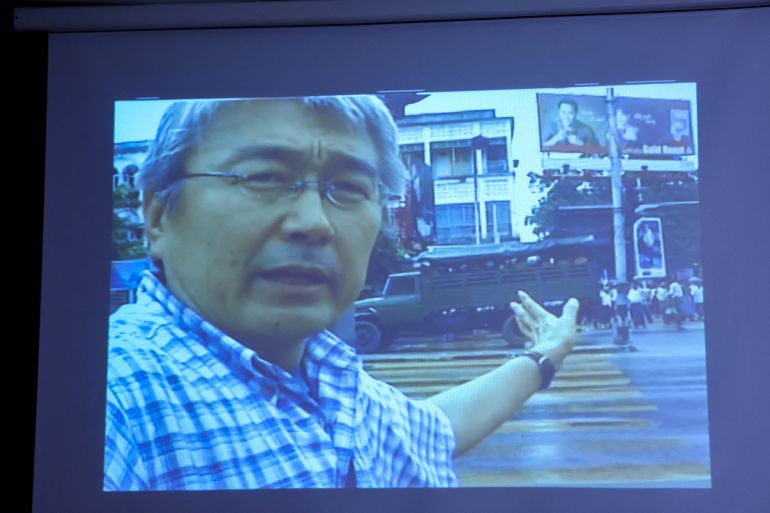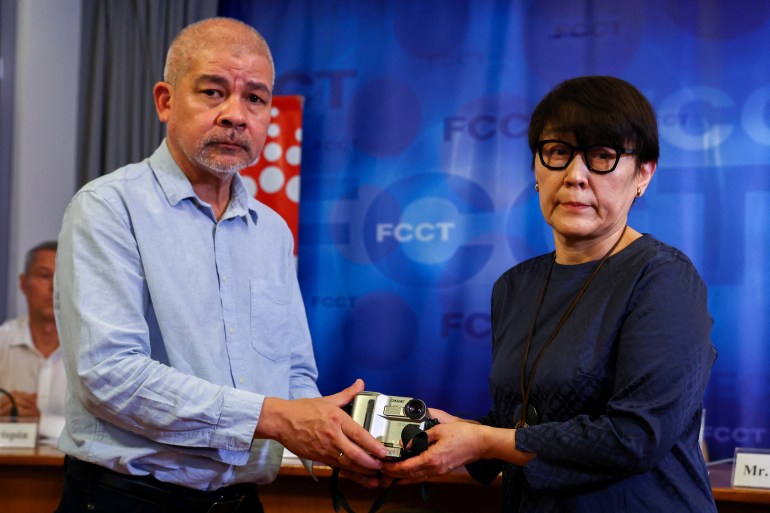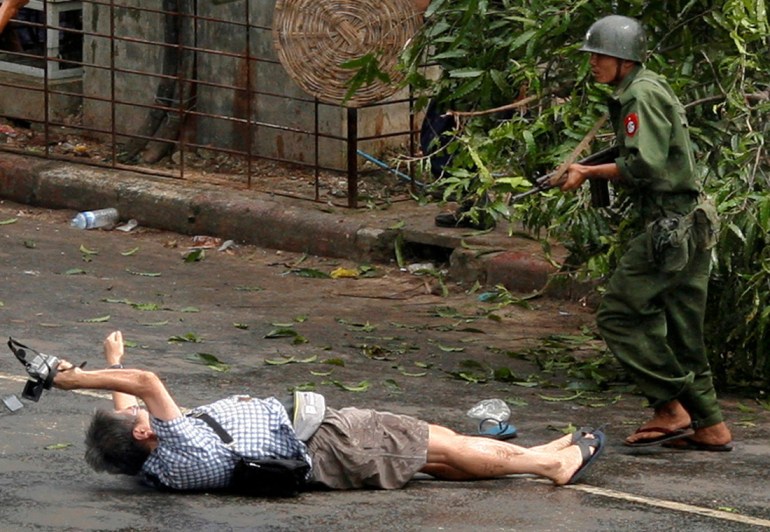Footage by Japanese journalist killed in Myanmar in 2007 released
Kenji Nagai was filming the monk-led Saffron Revolution in Yangon when he was shot by soldiers.

A video camera that had been missing for more than 15 years after it was dropped by a Japanese journalist who was fatally shot during a 2007 uprising in Myanmar has been handed over to his sister at a ceremony in Bangkok, and its final images released.
Kenji Nagai was in Yangon recording the protests led by Buddhist monks on September 27, 2007 – part of a peaceful uprising against decades of military rule known as the Saffron Revolution – when soldiers arrived and fired on the crowd. The 50-year-old journalist, who was working for Japan’s APF News, a small video and photo agency, was hit and fatally wounded. He was one of approximately 10 people killed that day.
Keep reading
list of 4 itemsMyanmar military pardons more than 3,000 prisoners for New Year
Dozens killed and wounded in Myanmar military air attacks
Thousands flee into Thailand amid renewed Myanmar fighting
Nagai’s sister Noriko Ogawa received the small Sony Handycam on Wednesday from Aye Chan Naing, head of the Democratic Voice of Burma, a Myanmar media organisation that was involved in its recovery.
“Thank you from the bottom of my heart,” she said. “This is a great surprise and joy for me, as I hadn’t even had any information about the camera until now.”
The handover of the camera comes with Myanmar in the grip of an upheaval even worse than that of 2007.
A widespread, determined armed resistance has emerged since the military seized power from Aung San Suu Kyi’s elected government in February 2021 and responded to mass protests against the coup with brutal force.
Some 3,440 people have been killed in the violence since, according to the Assistance Association for Political Prisoners, a monitoring group, with nearly 18,000 people in custody.
Three Myanmar journalists have been killed and more than 150 jailed. A handful of foreign journalists were also arrested and later deported.

The camera, when found, still had the original tape inside it. Its contents were screened at Wednesday’s event.
“Through this, I hope that people will once again turn their attention to Myanmar and I hope that people around the world will feel that something should be done about the current situation,” Ogawa told media in Bangkok.
She said the camera and footage would go back to Japan to be analysed and support a thorough investigation into her brother’s death, a case that had gone cold.
The images showed protesters and monks in the street close to Yangon’s ancient Sule Pagoda, singing and chanting, with police blocking their way. Trucks full of soldiers then arrived, prompting Nagai to turn the camera on himself.
“The army has arrived. Over there, that’s the army,” he says. “I think it’s a heavily armed army. In front of the temple, it is filled with citizens. Citizens are gathering in front of the head of the Buddha. A heavily armed army truck has arrived.”
The images then appear to show people scattering. The video cut off before the fatal moment.
However, video recorded by the Democratic Voice of Burma caught the moment of Nagai’s death, as he fell down and was then apparently shot at close range by a soldier. A photo of the incident taken by Adrees Latif of the Reuters news agency won a 2008 Pulitzer Prize.

Exact details of when and how Nagai’s camera was found and where it was kept in the intervening years remain vague. Aye Chan Naing said only that it had gone through a series of people before being taken out of Myanmar.
“For obvious security reasons, we cannot go deeper into how we get out. What I can tell you is we got it through a good citizen who knew what was right and what was wrong and that is how we got it,” he said.
Nagai’s sister said she hoped an analysis of the tape would debunk the military’s claim that he had not been deliberately targeted.
‘Improper site at improper time’
An op-ed in Myanmar’s state-controlled press less than a month after the shooting said Nagai was to blame for his own death because he put himself in harm’s way.
“The Japanese correspondent caused his tragic end by getting among the protesters,” it said. “Surely, the Japanese correspondent was shot accidentally, not on purpose. He met his tragic end due to the fact that he was together with the protesters at an improper site at an improper time.”
The article also complained that Nagai had entered the country on a tourist visa, not a journalist visa. Journalist visas were extremely difficult, if not impossible, to obtain during the Saffron uprising.
Shawn Crispin from the New York-based Committee to Protect Journalists, a press freedom group, said Myanmar remained a dangerous place for journalists to work.
“Today’s event is important and timely as a reminder that the Myanmar military has continued to kill journalists with impunity,” said Crispin, who took part in Wednesday’s ceremony. “And the killings won’t stop until Kenji’s murder receives full justice, from the triggerman, from any commanders that day who gave shoot-to-kill orders, to the military leaders who orchestrated that day’s lethal repression.”